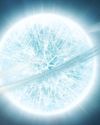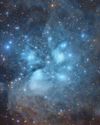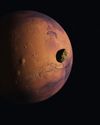MYSTERIES OF THE UNIVERSE - IS THE MOON WITH THE PLUMES HOME TO LIFE?
All About Space UK
|Issue 142
Scientists think they've found a way to work out if there's microbial alien life on Enceladus without plunging into its liquid ocean

Enceladus was once considered to be of little interest to astronomers. As one of 83 known moons of Saturn and just 500 kilometres (310 miles) in diameter, this cold, tiny world orbiting its gas giant host every 33 hours was largely overlooked as time-pressured astronomers focused their attention on other celestial bodies. It’s hard to blame them for doing so. Enceladus, discovered by William Herschel in 1789, had been visited by the two Voyager spacecraft, Voyager 1 and Voyager 2, in 1980 and 1981. Those flybys got as close as 90,000 kilometres (56,000 miles) from the moon’s surface, but they didn’t appear to find anything remarkable.
Instead it seemed as though Enceladus was simply frigid and inactive – a small stark-white dot covered in water ice reflecting all of the sunlight striking it from far away. But as time went on, more and more astronomers began to take notice of this moon. “People were suspecting that something about Enceladus was off,” affirms Dr Antonin Affholder, a postdoctoral research associate at the University of Arizona. “It seemed that the E ring of Saturn was somehow made out of material that comes out of Enceladus.”

Diese Geschichte stammt aus der Issue 142-Ausgabe von All About Space UK.
Abonnieren Sie Magzter GOLD, um auf Tausende kuratierter Premium-Geschichten und über 9.000 Zeitschriften und Zeitungen zuzugreifen.
Sie sind bereits Abonnent? Anmelden
WEITERE GESCHICHTEN VON All About Space UK

All About Space UK
MYSTERIES OF THE UNI WHERE ARE ALL THE SPIRAL GALAXIES?
There are far fewer spiral galaxies than elliptical ones in the Supergalactic Plane, and scientists are keen to discover why
7 mins
Issue 161

All About Space UK
ZOMBIE STARS
+10 OTHER TERRIFYING SPACE OBJECTS
8 mins
Issue 161

All About Space UK
HOW TO BEAT LIGHT POLLUTION
Thought it was impossible to observe the wonders of the night sky from towns and cities? Think again. Follow our tips and tricks on successfully observing through sky glow
2 mins
Issue 161

All About Space UK
15 STUNNING STAR CLUSTERS
These beautiful stellar groupings are spattered across the cosmos
8 mins
Issue 161

All About Space UK
Eileen Collins "It was a difficult mission...we were the first to see Mir"
Having served as both the first female pilot and first female commander of NASA's Space Shuttle, Collins boosted the involvement of women in space exploration to a whole new level
9 mins
Issue 161

All About Space UK
MARS LEAKS FASTER WHEN IT'S CLOSER TO THE SUN
The Red Planet has lost enough water to space to form a global ocean hundreds of kilometres deep
2 mins
Issue 161

All About Space UK
FUTURE TECH KANKOH-MARU
This ambitious reusable spacecraft will be capable of taking 50 people to and from orbit
2 mins
Issue 161

All About Space UK
THE FINAL FRONTIER
Beyond the reach of the Sun is a fascinating region of the cosmos that were only just beginning to explore
8 mins
Issue 161

All About Space UK
A long-lost moon could explain Mars' weird shape and extreme terrain
A long-lost moon could explain why Mars is so different from the other rocky planets in the Solar System. Today Mars has two tiny moons.
2 mins
Issue 161

All About Space UK
A sprinkling of cosmic dust may have helped kick-start life on Earth
Cosmic dust may have helped kick-start life on Earth. New findings challenge a widely held assumption that this wasn't a plausible explanation.
3 mins
Issue 161
Translate
Change font size

